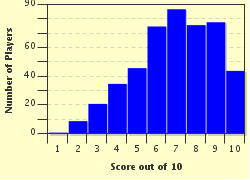Quiz Answer Key and Fun Facts
1. At the council of Nicaea in 325 CE a branch of Christianity called Arianism was declared heretical and all copies of the Thalia, the teachings of its leader Arius, were burned. Who was the emperor who had convened the council of Nicaea?
2. What city housed the world's greatest library in antiquity until it was burnt down in 391 CE? This city also contained one of the ancient seven wonders of the world.
3. In 1209 pope Innocent III instigated a crusade against a Christian sect locally known as the Albigensians. After their supporters were crushed in a 20 year campaign the Inquisition was set up and Albigensians who refused to recant their beliefs were burnt, as well as many books with their teachings. What is the more commonly known name for Albigensians?
4. Who was the first Grand Inquisitor of the Spanish inquisition? In this position he condemned thousands of people to death at the stake and he also organised the burning of many Jewish religious books.
5. After the Spanish conquest of Yucatan many Maya codices and idols were burnt on the orders of Diego de Landa. The extent of the destruction was so large that today only three Maya codices survive. One is in a museum in Madrid, another in Paris. The third can be found in a German city notorious for being bombed heavily by Allied forces in World War II. Which city is this?
6. In the beginning of World War I German soldiers looted and set fire to a Belgian city. About half of it was burnt down together with its university library. 250,000 books and irreplaceable medieval manuscripts went up in flames. Which Belgian city and its library was burnt down by the invading German army?
7. In 1933 German student organisations, supported by leading Nazis, organised a nationwide campaign of book-burnings. In 25 university towns piles of books considered 'un-German' were erected and burnt. These actions were condemned on a global scale and gained so much notoriety they found their way into popular culture. In which Indiana Jones movie does the leading character witness a Nazi book-burning?
8. In 1966 a period of civil unrest and violence started in China during which most of China's age old literature and calligraphy was destroyed. What is the name of this period of upheaval?
9. In 2011 a Florida pastor burnt a Quran after it had been found guilty of promoting violence in a 'trial' organised by his church. Who is this pastor, who shares his name with a member of Monty Python's Flying Circus?
10. If we may believe Ray Bradbury's novel published in 1953 book burnings will also be a thing of the future. In this book protagonist Montag is a fireman, which means he has to start fires in stead of putting them out. What is the name of this novel?
Source: Author
AlonsoKing
This quiz was reviewed by FunTrivia editor
bloomsby before going online.
Any errors found in FunTrivia content are routinely corrected through our feedback system.

